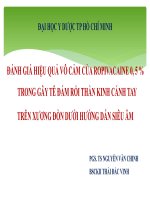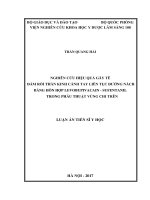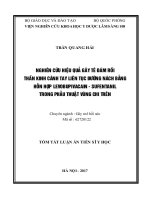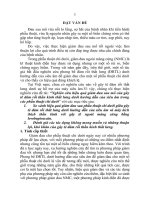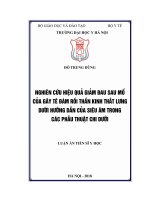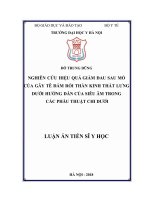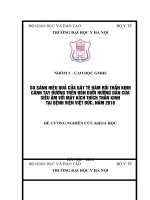Nghiên cứu hiệu quả vô cảm trong mổ và giảm đau sau mổ của gây tê đám rối thần kinh cánh tay bằng hỗn hợp bupivacain dexmedetomidin trong kết hợp xương chi trên tt tiếng anh
Bạn đang xem bản rút gọn của tài liệu. Xem và tải ngay bản đầy đủ của tài liệu tại đây (697.56 KB, 27 trang )
MINISTRY OF EDUCATION AND TRAINING
MINISTRY OF DEFENCE
108 INSTITUTE OF CLINICAL MEDICAL AND PHARMACEUTICAL SCIENCES
-------------------------------------------------
TRAN THI CAM NHUNG
RESEARCH ON EFFICACY OF INTRAOPERATIVE
ANESTHESIA AND POSTOPERATIVE ANALGESIA BY
MIXTURE OF BUPIVACAINE WITH DEXMEDETOMIDINE
IN BRACHIAL PLEXUS BLOCK
FOR UPPER EXTREMITY BONE SURGERY
Speciality: Anesthesiology
Code: 62720122
ABSTRACT OF MEDICAL DISSERTATION
Hanoi - 2020
THE THESIS HAS DONE IN: 108 INSTITUTE OF CLINICAL
MEDICAL AND PHARMACEUTICAL SCIENCES
Supervisors:
1. Prof. Dr. Nguyen Van Chung
2. Dr.Tong Xuan Hung
Reviewers:
1. Prof. Dr. Nguyen Huu Tu
2. Ass. Prof. Dr. Bui Van Manh
3. Ass. Prof. Dr. Le Van Doan
Archives:
1. National Library of Vietnam
2. Library of 108 Institute of Clinical Medical and
Pharmaceutical Sciences
1
INTRODUCTION
Upper extremity fractures are a common and they appear in
every subject. According to statistics of Nguyen Duc Chinh et al
from 2016 to 2018, 90011 patients of accidents at Viet Duc Hospital,
the proportion of this cases had accounted for 53.2% with lower and
upper extremity injuries. The study of Karl in the United States, the
epidemiology of upper extremity fractures accounted for 677/100000
patients in 2009. Among anesthesia methods for upper extremity
surgery, brachial plexus block is usual technique due to simple but
highly effective anesthesia for this surgery.
To reduce dose of local anesthetic, increase effect this
anesthetic in brachial plexus block, prolong the analgesic effect after
surgery, many authors have had researches adding local anesthetics
with drug such as sufentanil, fentanyl, morphine, dexamethasone,
ketorolac, clonidine, or dexmedetomidine. In Viet Nam, there has
been no any research on a combination of local anesthetic with
dexmedetomidine, so we have conducted a project "Research on
efficacy of intraoperative anesthesia and postoperative analgesia by
mixture of bupivacaine with dexmedetomidine in brachial plexus
block for upper extremity bone surgery”, following two objectives:
1. To compare intraoperative anesthetic and postoperative
analgesic
efficacy
of
75mg
bupivacaine
and
100mcg
dexmedetomidine mixture with bupivacaine alone by brachial
plexus block for upper extremity bone surgery.
2. To evaluate on blood pressure, heart rate, sedative effect and
some adverse effects of 75mg bupivacaine and 100mcg
dexmedetomidine mixture by brachial plexus block for upper
extremity bone surgery.
2
Chapter 1
OVERVIEW
1.1. Upper extremity fracture
Causes of the upper extremity fractures are popular due to
domestic accidents, machinery, playground injury or road traffic
accidents. In particular, the author Rubin and his colleagues reported
103465 cases of traffic accidents which had 17263 situations of
upper extremity fractures, the ratio of open fractures accounted for
16.7%, about 18.1% at adults and 13.2.% at children. In the
Netherlands, the frequency of upper extremity fractures had
accounted about 824/100 000 people for 9 years from 2004 to 2012
and tended to grow up following next time, more regularly in a group
of 16-35 years old, more man than female.
1.2 Anesthetic techniques for upper extremity bone surgery
There are many anesthetic techniques for upper extremity
surgeries, such as intravenous regional anesthesia (Bier block),
brachial plexus block, general anesthesia.
Advantages of brachial plexus block are not only simple
technique, but also reducing or losing provisional sensation and
movement of upper extremity. Patients still awaken, recovery early,
lessen caring of health care staff and family’patient. Especially, it is
lower cost than general anesthesia.
1.3 Brachial plexus block
The brachial plexus is formed from five roots, the anterior rami
of the spinal nerves from C5 - T1, they connect together to form 3
trunks, after the roots pass between the scalene muscles they meet
the subclavicular artery and divide into divisions.
3
In the three trunks, the superior trunk arises from the union of
the C5 - C6 root. The middle trunk is formed by the C7 root. The
inferior trunk is formed by the C8 - T1 root. Each trunk continues to
divide into two: the anterior and posterior division. After that, six
dividions connect together and form three cords. The lateral cord is
formed from connection of two anterior divisions from the superior
trunk and the middle trunk. The medial cord is an anterior division of
the inferior trunk and the posterior cord is composed of three
posterior divisions. The three cords give rise to major nerves which
control
sensation
and
movement
of
upper
extremity,
are
musculocutaneous nerve, radial nerve, median nerve and ulnar nerve.
The benefit of supraclavicular brachial plexus block is to
anesthetize whole upper extremity. Thus, it should be considered
"spinal block for upper extremity", and indicated for arm, elbow,
forearm and hand surgeries. Because almost the brachial plexus
merges into a mass, blocking this position can do anesthesia for all
branches and rapid onset time of sensory block due to small nerves
and minimum local anesthetic.
Supraclavicular brachial plexus block may have some
complications such as about 0.04 - 1% pneumothorax, subclavicular
artery puncture, Claude Bernard Horner syndrome, phrenic nerve
block rarely.
1.4 Using drug in brachial plexus block of our study
Bupivacaine which is local anesthetic, is exerted to block
recoverable conduction of nerve impulse, through mechanism to
inhibit depolarization of neural membrane by preventing of Na+ to
pass this membrane. Bupivacaine inhibits stronger sensory fibers
than motor fibers, because motor fibers have myelin sheath and
4
diameter of these fibers larger than sensory fibers. The duration time
has about 3 - 4 hours.
Dexmedetomidine is a highly selective a2 adrenoreceptor
agonist which has eight times higher effective than clonidine’s. The
ratio of a2:a1 adrenoreceptor of dexmedetomidine is approximately
1620:1, to have anxiolytic, sedative and analgesic effect. Four
analgesic mechanism of dexmedetomidine in brachial plexus block
are demonstrated by Brummett C (2008) through stimulation of
central and peripheral α2 adrenoreceptor, causing central analgesic
effect, vasoconstriction around injection site, anti-inflammatory and
direct analgesic effect on peripheral nerves. Dexmedetomidine
connects with anesthetic drug helps to prolong the duration of
anesthesia and analgesia on the peripheral nerve through the indirect
mechanism due to vasoconstriction at the injection site, however, the
vasoconstrictive level of dexmedetomidine is less than epinedrine’s.
It is important that high doses of dexmedetomidine has not affected
the histopathology of the neural axon and myelin which were
monitored at 24 hours and 14 days.
5
Chapter 2
SUBJECTS AND METHODS
2.1 STUDYING SUBJECTS
Male and female patients, who had been undergone elective
surgeries of arm or/and forearm fracture by supraclavicular brachial
plexus block.
2.1.1 Selection criteria for study patients
Patients who agreed to participate in the study, aged 15-75 years,
ASA grade I – III.
2.1.2 Exclusive criteria
- Patients had disorder of atrial-ventricular conduction,
bradycardia < 50beats/minute. Psychiatric disorder, epilepsy,
neuromuscular diseases. Renal or hepatic failure.
- History of allergy local anesthetics, alcoholism or drug abuse
- Pregnancy or lactating women, patient’s weigh < 35 kg
2.1.3 Rejective criteria from study
Patient had multiple injuries, combined upper extremity surgery
with other surgeries, surgical complication or not collected enough
data.
2.2 TIME AND LOCATION OF STUDY
The study was practiced from February, 2016 to May, 2017 at
Anesthesia and Orthopedic Department in Can Tho Central General
Clinic Hospital.
2.3 RESEACH METHODOLOGY
2.3.1 Study Design: It was a controlled, randomized, interventional
prospective clinical study.
2.3.2 Sample size and division of patient group
Using the test formula for comparison of two average numbers
6
2C
( ES ) 2
α is the probability of type 1 error, α = 5%, β is the probability of
n
type 2 error, β = 20%, to look at table 3 and get a constant C = 7.85.
In a study of Agarwal S. (2014), μ1 which is postoperative analgesic
time of bupivacaine with dexmedetomidine group, is 776 minutes
and σ1 which is standard deviation of postoperative analgesic time, is
130.8 minutes. μ2 is the expected postoperative analgesic time in our
study when we will use a connection of bupivacaine with
dexmedetomidine, increasing about 10% postoperative analgesic
time of Agarwal’s study, so this time is 850 minutes.
Filling this parameters into this formula, and calculating n =
49.1. Therefore, we selected 54 patients for each group.
2.3.3. Devices, facilities and drugs of research
- Ultrasound machine with linear probe, frequency 6 - 12MHz of
Ezono AG company.
- Stimuplex A needle for brachial plexus block of B. Braun company.
- VAS (Visual Analog Scale) ruler .
- Multi-parameters monitoring of Nihon Kohden company.
- Bupivacaine Aguettant 20 ml 0.5% of Delpharm Tours, France
- Dexmedetomidine (PrecedexR), 200mcg/2ml of Hospira.Inc, North
Chicago.
- Emergency drugs: atropine, ephedrine, adrenaline, noradrenaline,
intralipid 20%.
- Kinds of infusion: lactate ringer, sodium chloride 0.9%,
2. 3.4 Study procedure
2.3.4.1 Preoperative period
The day before surgery: examined and measured height,
7
weight, and classified ASA. Instruct patients to identify pain level on
VAS ruler. Explain to the patient about the technique of anesthesia
and some possible adverse-effects. If the patient agreed to participate
in this study, he/she would sign a consent form and be drawn to the
study subgroup. No one is used analgesic at the surgerical morning.
2.3.4.2 At the operating room
Patients would be watched for ECG, HA, breathing rate, SpO2
by monitoring and recorded these indexes at that time of study.
Administer 3liter/min oxygen through the nasal tube. Doing
intravenous line with 18G needle, and infusing ringer lactate about
30 drops/min.
To prepare 30 ml mixture of local anesthetics:
+ B Group: 15 ml of bupivacaine 0.5% plus 15 ml of 0.9%
sodium chloride to obtain 30 ml of bupivacaine 0.25%.
+ BD group: 15 ml of bupivacaine 0.5% plus 100mcg /1ml of
dexmedetomidine, and 14ml of 0.9% natricloride to get 30ml
mixture of bupivacaine 0.25% and 100mcg dexmedetomidine.
2.3.4.3 Practice by supraclavicular brachial plexus block via
ultrasound guidance
The patient's position was lying on an operative table, injuried
hand was closed to body, his head was faced to the opposite side of
brachial plexus block. An anesthesiologist used an ultrasound probe
to determine location of the brachial plexus where is above the
clavical bone. Holding the transducer plane in a direction that was
parallel to body's axis, so that ultrasound beam crossed the brachial
plexus and subclavicular artery located on the first rib. Once the
brachial plexus was adequately identification of the neural structures
as round or oval multiple hypoechoic structures, next to the
8
subclavicular artery. We injected needle slowly and observed its
direction of on the screen, keeped it below the brachial plexus, next
to the subclavicular artery. An assistant installed the syringe
containing mixture of local anesthetic with connected line of needle,
drawed this syringe test if there was no blood, started to inject 3-5ml
then checked again per each time after injection. When anesthetic
mixture was injected 15ml, needle was stopped and moved it
upwards to brachial plexus, continued to inject 15ml of this
anesthetic, the anesthetic mixture slowly spread around brachial
plexus on screen of ultrasound.
To monitor the patient in 30 minutes after brachial plexus
block: if the patient had completed pain sensory blockage, surgery
would be performed. If the patient was still moderate pain, we would
give them fentanyl 1-2 mcg/kg, and/or midazolam 0.02 - 0.04 mg/kg
by intravenous injection in case of anxiety. Continuing this
evaluation after 5 minutes, if the patient was still severe pain, we
would change to general anesthesia. All patients in both groups are
given paracetamol 1g/100ml at the end of the surgery.
2.3.5 Accessment standards of study
2.3.5.1 General characteristics of the patient and surgery
Age, gender, height, weight, historical chronic diseases, ASA
classification, location and time of surgery.
2.3.5.2 Comparison intraoperative anesthetic and postoperative
analgesic efficacy of mixture’s bupivacaine and dexmedetomidine
with bupivacaine alone by brachial plexus block
- The onset time and level of pain sensory blockage dermatomes
where be controlled by radial nerve, median nerve and ulnar nerve.
- The onset time and level of pain sensory blockage on
9
dermatomes where be controlled by roots from C5 to T2 .
- The onset time and level of pain sensory blockage whole
dermatomes of arm surgery.
- The onset and duration time of motor blockage
- Level of motor blockage.
- Intraoperative anesthetic efficiency
- Postoperative analgesic efficiency: duration time and VAS
score at rest and movement, used analgesics after surgery
2.3.5.3 Evaluation on blood pressure, heart rate, sedative effects
and some adverse effects mixture of bupivacaine with
dexmedetomidine by brachial plexus block
- Monitor blood pressure: systolic blood pressure (SBP),
diastolic blood pressure (DBP), average blood pressure (ABP), heart
rate.
- Sedative effect: onset and duration time, sedative level.
- Monitor breathing rate and SpO2.
- Adverse effects due to local anesthetic
-Adverse effects due to anesthetic technique
2.3.6 Methods of evaluation
- Evaluation of pain sensory blockage by pin-prick method: after
anesthesia, we used a needle to prick test sensory pain on
dermatomes where be controlled by roots from C5 to T2, and radial
nerve, median nerve, ulnar nerve, compared with the opposite side.
In particular, C5 dominates sensory pain of arm’s outside, C6
dominates sensory pain of forearm’s outside, C7 dominates sensory
pain of the hand, C8 dominates sensory pain of the forearm’s inside,
T1 dominates sensory pain of the arm’s inside and T2 dominates
sensory pain of underarm. The radial nerve dominates sensory pain
10
on the back of the thumb and II finger, the median nerve dominates
sensory pain on the palm of III and IV finger, the ulnar nerve
controls sensory pain on the palm of V finger.
- The level of pain sensory blockage for upper extremity during
surgery was assessed following the author Agarwal’s research,
divided to 3 grades, grade 0: normal sensation; grade 1: a little loss
of sensation of pin-prick (analgesia); grade 2: complete loss of pain
sensation (anesthesia).
- The level of motor blockage for upper extremity was assessed
by Bromage scale, divided into 3 grades, grade 0: normal motor
function with full flexion and extension of elbow, wrist, and fingers;
grade 1: decreased motor strength with ability to move the fingers
only; grade 2: Complete motor block with inability to move the
fingers
- Intraoperative anesthetic efficiency was assessed by the author
Abouleish E., divided into 4 levels, excellent: patient completely no
felt pain and no supplementary drug was required; very good: patient
felt mild pain and was given 50 mcg fentanyl; good: patient felt
moderate pain and was given 100 mcg fentanyl, poor: patient felt
severe pain and was required 100 mcg fentanyl but they could not
bear pain and could be changed general anesthesia.
- The level of postoperative analgesia was evaluated by VAS
score, divided into 4 levels, VAS = 0: no pain, VAS = 1 - 3: mild
pain, VAS = 4 - 6: moderate pain, VAS = 7 - 10: severe pain
- The level of intraoperative sedation was evaluated by OAA/S
score, OAA/S = 5 score: alert; OAA/S = 4: light sleep; OAA/S = 3:
moderate sleep; OAA/S = 2: deep sleep; OAA/S = 1: very deep
sleep, unconscious.
11
2.3.7 Standards and definitions using for study
- Onset time of pain sensory blockage of each root from C5 to T2
root, radial nerve, median nerve, ulnar nerve was defined as the time
from the end of local anesthetic administration until patient felt a litte
loss sensory block with grade 1 according to the classification of
Agarwal, unit in minutes.
- Onset time of pain sensory blockage of whole upper extremity
is defined as the time from the end of local anesthetic administration
until patient feel loss sensory block with grade 1 according to the
classification of Agarwal, was dominated by roots from C5 to T2, and
radial nerve, median nerve, ulnar nerve, unit in minutes.
- Duration time of pain sensory blockage of whole upper
extremity was defined as the time from patient felt loss sensory block
with grade 1 until completely sensory recovery with grade 0
according to the classification of Agarwal, unit in minutes.
- Onset time of motor blockage was defined as the time from the
end of local anesthetic administration until patient decreased motor
strength with ability to move the fingers only, grade 1 according to
the classification of Bromage, unit in minutes.
- Duration time of motor blockage was defined as the time from
patient decreased motor strength with ability to move the fingers
only (grade 1) until completely motor recovery (grade 0), unit in
minutes.
- Postoperative analgesic time was defined as the time from the
end of the surgery to the time of pain appearance, unit in minutes.
- Hypotension: systolic blood pressure (SPB) was less than 90
mmHg in a case of an initial SPB 110 mmHg, or SPB droped of
more than 20% of the initial SPB = 90 - 109 mmHg.
12
- Bradycardia: heart rate was slow when < 50 beats/minute in the
initial frequency with 60 - 100 beats/minute or heart rate droped of
more than 20% of the initial frequency = 50 - 59 beats/minute.
- Onset time of sedation was defined as the time from the end of
local anesthetic administration until patient had OAA/S = 4 score and
recorded the sedative level, unit in minutes.
- Duration time of sedation was defined the time from patient
had OAA/S = 4 score until OAA/S = 5 score, unit in minutes.
- Prevalence of patients using sedative and analgesic drugs at
intraoperative time when they were supplied midazolam and/or
fentanyl.
2.4 DATA ANALYSIS
- The data was processed and analyzed by medical statictic
method with SPSS 16.0 software for Window.
- Quantitative variables were compared the average value of two
independent groups using Student t-test, and represented as mean and
standard deviation ( X ± SD), Min - Max. Qualitative variables were
represented by frequency and percentage, and the χ2 test was used to
evaluate difference for qualitative variables. Comparing differences
was statistically significant when p < 0.05.
2.5 MORAL ISSUES IN STUDY
During study process, we always followed approval of the
Ethical Committee in biomedical research under decision No.
5129/2002/QD-YT on December 19, 2002 of the Health Minister
13
Diagram study
Select patients to study,
divided into two groups
Group B, 54 patients
Group BD, 54 patients
Brachial plexus block, 30 ml
bupivacain 0.25% (75mg)
Brachial plexus block, 30 ml
bupivacain 0.25% +
dexmedetomidin 100 mcg
General characteristics of the patient and surgery
- Age
- ASA classification
- Gender
- Historical chronic disease
- Weight, height
- Surgical location
- BMI
- Time surgery
Comparing intraoperative anesthetic and postoperative analgesic efficacy
- Sensory blockage: level, onset and duration time
- Motor blockage: level, onset and duration time
- Intraoperative anesthetic efficiency
- Postoperative analgesic efficacy: analgesic time và VAS score
Evaluation on BP, heart rate, sedative effects and some adverse effects by
mixture of bupivacaine with dexmedetomidine
- Vital signs by monitor: BP, HR, ECG, SpO2 at before and after
brachial plexus block.
- Intraoperative sedation: level, onset and duration time
- Some adverse effects
- Record some adverse effects
14
Chapter 3
RESEARCH RESULTS
3.1. General characteristics of study patients
Table 3.1. Age, height, weight and BMI Characteristics
Group
B Group
BD Group
n = 54
n = 54
Age (years old)
38.3 ± 16.3
37 ± 13.3
(min - max)
(15 - 72)
(16 - 64)
Height (cm)
162.0 ± 7.1
163.4 ± 7.4
(min - max)
(145 - 176)
(148 - 176)
Weight (kg)
59.9 ± 12.0
59.1 ± 11.0
(min - max)
(37 - 105)
(40 - 90)
BMI (kg/m2)
22.7 ± 4.0
22.1 ± 3.4
(min - max)
(16.6 - 38.6)
Characteristics
Conclusion:
There
is
no
(16.9 - 31.1)
significant
p
> 0.05
> 0.05
> 0.05
> 0.05
differences
about
demographic characteristics such as age, height, weight and BMI in
patient of both groups, p > 0.05.
3.2 Intraoperative anesthetic and postoperative analgesic efficacy
3.2.1 Intraoperative anesthetic efficacy
15
Prevalence %
81.4
100
61.1
50
Group B
Group BD
20.4
p < 0.05
13
18.5
5.6
0
Excellent
Very good
Anesthetic
Good
Figure 3.1 Intraoperative anesthetic efficacy of both groups
Conclusion: The BD group has intraoperative anesthetic
efficiency at excellent and very good level statistically significantly
higher than that of BD group with p < 0.05 and there is any case to
change general anesthesia in both groups.
Table 3.13. Onset and duration time of sensory and motor block
Time of sensory and motor block (minutes)
Group
Time
Onset of sensory block
Duration of sensory
block
Onset of motor block
grade 1
Onset of motor block
grade 2
Duration of motor
block
(min - max)
Group B (n = 54)
Group BD (n = 54)
17.1 8.3
(7 - 44)
486.6 206.2
(190 - 1035)
18.7 6.3
(8 - 33)
31.1 8.7
(12 - 46)
417.7 199.3
(140 - 910)
11.1 4.6
( 3 - 20)
824.5 244.8
(305 - 1630)
12.2 5.3
(4 - 28)
19.6 6.0
(10 - 34)
800.5 248.9
(180 - 1530)
p
< 0.05
< 0.05
> 0.05
< 0.05
< 0.05
Conclusion: Onset time of sensory and motor block with grade 2
in the BD group is statistically significant shorter than that of B
group, p < 0.05. In addition, duration time of sensory and motor
block in the BD group is longer than that of B group, p < 0.05.
16
3.2.2 Postoperative analgesia duration
Table 3.16. Duration time of postoperative analgesia
Group
Time
Group B
Group BD
n = 54
n = 54
p
Postoperative analgesia (minutes) 552.7 231.2 970.5 309.5
< 0.05
(min - max)
(170 - 1215) (375 - 1660)
Conclusion: Duration time of postoperative analgesia in BD group
is statistically significantly longer than B group’s, p < 0.05.
3.3 Blood pressure, heart rate, sedative effects and some adverse
effects of bupivacaine and dexmedetomidine mixture by brachial
plexus block
3.3.2 Effect on heart rate
Heart rate
(beats/minute
B group
BD group
Time
Figure 3.7 Heart rate of two research groups
*: p < 0.05
Conclusion: Heart rate from T20 to T90 in BD group is
statistically significantly lower than that of B group, p < 0.05.
17
3.3.3 Sedative effect
Prevalence %
87
100
Group B
80
60
Group BD
46.3
37
40
p < 0.05
16.7
20
9.3
3.7
OAA/S Score
0
OAA/S 5
OAA/S 4
OAA/S 3
Figure 3.8. Intraoperative sedative effect
Conclusion: OAA/S = 4 score in BD group is about 87%, more
than that of B group, only about 37%, the difference is statistically
significant, p < 0.05.
Table 3.18. Sedative time in BD group
Time of sedation (minutes)
BD Group (n= 48)
Onset
9.8 3.5
(min - max)
(4 - 18)
Duration
92.7 34.1
(min - max)
(50 - 200)
Conclusion: BD group has onset of sedative time which is 9.8
3.5 minutes and duration time is 92.7 34.1 minutes.
18
3.3.4 Adverse effects
Adverse effects
Horner syndrome
Group BD
Group B
14.8
5,6
Vomiting
7,4
Nausea
Hypotension
1 .9
Bradycardia
1 .9
*
11,1
18,5 *
Prevalence %
0
10
20
Figure 3.12. Comparison adverse effects of both groups
Conclusion: Bradycardia and nausea in BD group are
statistically significantly more than B group’s, p <0.05.
19
Chapter 4
DISCUSSIONS
4.1. General characteristics of study patients
The average age in B and BD group is respectively 38.3 16.3
and 37 13.3 years old, the smallest is 15 years old and the highest
is 72 years old according to table 3.1. Consequently, the both groups
of our study have similar age characteristics, p > 0.05. The average
age in our study resembles to domestic author such as in Do Thi Hai’
research, age was 33 years old, the youngest was 13 years old and
the highest was 56 years old.
4.2 Comparing intraoperative anesthetic and postoperative
analgesic efficacy of bupivacaine and dexmedetomidine mixture
with bupivacaine alone
We find that the result of figure 3.1 when using bupivacaine
combined with dexmedetomidine, improves anesthetic effect very
well, excellent and very good level in BD group accounting for
94.4%, in good about 5.6% statistically significantly higher than B
group, in turn 81.5% and 18.5%, p < 0.05. The author Nguyen Van
Huan’ research (2008) used axillary brachial plexus block by nerve
stimulator, the rate of anesthetic effect was very good at 93.4% and
good at 6.6%. The successful rate of author Nguyen Thi Thanh’s
research (2013) was 91.4% by nerve stimulator. Tripathi A.’s
research (2016), anesthetic effect in BD group had 80% at very good
and 20% at good. Conclusion, anesthetic efficacy of our study is
similar to prevelance of domestic and foreign authors’s research.
In BD group of our study, onset time of sensory blockage on
whole upper extremity is 11.1 4.6 minutes, 3 minutes fastest and the
20 minutes longest, shorter than that of group B, is 17.1 8.3 minutes,
20
7 minutes fastest and 44 minutes longest, the difference is
statistically significant between both groups, p < 0.05. Moreover,
onset time of mortor blockage in BD group of our research is 19.6
6.0 minutes, statistically significantly shorter than that of B group,
with 31.1 8.7 minutes. In addition, according to table 3.13, duration
time of sensory and motor block in BD group are respectively 824.5
244.8 minutes and 800.5 248.9, longer than B group’s, in turn
486.6 206.2 minutes and 417.7 199.3 minutes, this difference is
statistically
significant,
p
<
0.05.
Therefore,
addition
of
dexmedetomidin to local anesthetic can decrease waiting time for
surgery due to quickly onset time and prolong duration time of
anesthesia, thus it can be suitable for complex surgeries. In the study
of Gandhi R. and et al. (2012), the onset of sensory and motor blockage in
combined dexemedetomidine group was faster than alone local anesthetic
group, duration of sensory and motor blockage were 732 minutes and 660
minutes, shoter than about 100 minutes of our BD group, is 825 and 800
minutes, explaining this difference may be due to two different assisted
technique in practiced anesthesia, we did ultrasound guidance while Gandhi
R. used anatomical technique to do brachial plexus block.
In addition, postoperative analgesic time was 776 minutes of added
dexmedetomidine group in Agawal’s research (2014), shorter than that of our
BD group with 970 minutes (table 3.16), although both studies used the same
100mcg dexmedetomidine, but we used ultrasound guidance to help this
drugs access brachial plexus better. Besides, research of Biwas S. and et al
(2014), recorded postoperative analgesic time of local anesthetic and 100mcg
dexmedetomidin was 997 minutes, it is seem similar to our study. Thus,
combination of dexmedetomidine to local anesthetic in brachial plexus block
21
can prolong postoperative analgesic time has been shown by many studies,
even if only a single dose of dexmedetomidin is used for one injection.
4.3 Evaluating on blood pressure, heart rate, sedative effects and
some adverse effects of bupivacaine and dexmedetomidine
mixture by brachial plexus block for upper extremity bone
surgery
There are about 50% patients who feel anxious during perioperative
time, so sedation for patients is extremely necessary, helping patients feel
secure and cooperative. According to the chart 3.4, BD group in our study has
about 87% of OAA/S = 4 points, higher than B group’s, only 37%,
statistically significant difference, p < 0.05 (figure 3.8). Onset and duration of
sedative time are 9.8 3.5 minutes and 92.7 34.1 minutes (table 3.18).
Thus, our sedative time is very suitable with surgical time because of reducing
to patient’s anxiety during intraoperative time. In Vietnam, Hoang Quoc
Thang and et al. (2012) evaluated sedative effect of 0.25mcg/kg
dexmedetomidine by intravenous route in colonoscopy procedure, recording
the onset and duration of sedative time were 11 3.3 minutes and 37.2 6.9
minutes, achieved 3 sedative level on the Ramsay scale, equivalent to deep
sleep but easy to wake up accounting for nearly 80%. Therefore, our study
has onset and level of sedation similar to author Hoang Quoc Thang, although
using different routes.
The BD group in our study has heart rate at figure 3.7 statistically
significantly lower than that of B group from 20th minute to 90th minute after
regional anesthesia, p < 0.05. Incidence of bradycardia and nausea in BD
group accounts for 18.5% and 7.4% statistically significantly higher than B
group is 1.9% and 0%, p < 0.05 (figure 3.12). However, other adverse effects
such as hypotension, vomiting and Horner syndrome have not had
statistically significantly different between both groups, p > 0.05.
22
Comparing foreign studies with dexmdedetomidin, Agawal S. (2014)
reported that BD group had heart rate slower than B group’s from 30th minute
to 120th minute after brachial plexus block, a statistically significant
difference, p < 0.001. In addition, research of Nazir N. (2016) also noted that
heart rate in BD group at 30, 60, 90 and 120 minute was statistically
significantly lower than that of B group, p < 0.05. This result is similar to our
study. Thus, addition of dexmedetomidine to local anesthetics in brachial
plexus block will make bradycardia.
23
CONCLUSIONS
Our study of supraclavicular brachial plexus block under
ultrasound guidance for 108 patients who had divided two groups,
the BD group received 75mg bupivacaine and 100 mcg
dexmedetomidine comparison to the B group received 75mg
bupivacaine, some conclusions as follows:
1. The BD group has onset time of sensory and motor blockage
which is 11.1 4.6 minutes and 19.6 6.0 minutes faster than that of
B group, gets 17.1 8.3 minutes and 31.1 8.7 minutes, p < 0.05.
Moreover, the prevalence of achieved excellent and very good
anesthesia which is 94.4% and 5.6% at good anesthesia in BD group
statistically significantly more than group B has respectively had
81.5% and 18.5%, p < 0.05. In addition, postoperative analgesic time
is 970.5 309.5 minutes in BD group more than group B, is 552.7
231.2 minutes, p < 0.05. BD group has had rested and motivational
VAS score statistically significantly lower than that of B group at 12,
16 and 24 hour after brachial plexus block, p < 0.05.
2. The BD group has had an average blood pressure from 45th
minute to 120th minute lower than B group’s, p < 0.05. In addition,
heart rate of BD group has shown lower than B group’s from 20th
minute to 120th minute after brachial plexus block, statistically
significant differences, p <0.05.
The sedative effect in BD group is OAA/S = 4 score accounting
for 87%. In addition, BD group has onset and duration of sedative
time which is 9.8 3.5 minutes and 92.7 34.1 minutes. The ratio of
patients with bradycardia and nausea in BD group is 18.5% and
7.4%, respectively.
